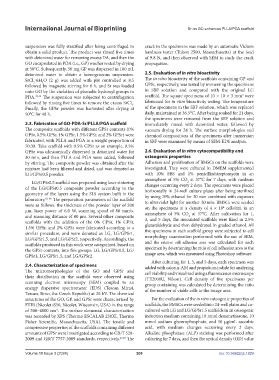Page 208 - IJB-10-3
P. 208
International Journal of Bioprinting Sr on GO enhances PLLA/PGA scaffold
suspension was fully stratified after being centrifuged to crack in the specimens was made by an automatic Vickers
obtain a solid product. The product was rinsed five times hardness tester (Tukon 2500, Massachusetts) at the load
with deionized water for removing excess DA, and then the of 9.8 N, and then observed with SEM to study the crack
GO encapsulated in PDA (i.e., GP) was harvested by drying propagation.
at 50°C. Subsequently, 50 mg GP was dispersed in 100 mL
deionized water to obtain a homogeneous suspension. 2.5. Evaluation of in vitro bioactivity
SrCl 6H O (2 g) was added with pH controlled at 8.5 The in vitro bioactivity of the scaffolds containing GP and
2
2
followed by magnetic stirring for 6 h, and Sr was loaded GPSr, respectively, was tested by immersing the specimens
onto GO by the chelation of phenolic hydroxyl groups in in SBF solution and compared with the original LG
3
PDA. 39,40 The suspension was subjected to centrifugation scaffold. The square specimens of 10 × 10 × 3 mm were
followed by rinsing five times to remove the excess SrCl . fabricated for in vitro bioactivity testing. The temperature
2
Finally, the GPSr powder was harvested after drying at of the specimens in the SBF solution, which was replaced
50°C for 48 h. daily, maintained at 36.5°C. After being soaked for 21 days,
the specimens were removed from the SBF solution and
2.3. Fabrication of GO-PDA-Sr/PLLA/PGA scaffold immediately rinsed with deionized water, followed by
The composite scaffolds with different GPSr contents (0% vacuum drying for 24 h. The surface morphologies and
GPSr, 0.5% GPSr, 1% GPSr, 1.5% GPSr, and 2% GPSr) were chemical compositions of the specimens after immersion
fabricated, with PLLA and PGA in a weight proportion of in SBF were examined by means of SEM-EDS analysis.
70:30. Take scaffold with 0.5% GPSr as an example, 0.5%
GPSr was ultrasonically dispersed in deionized water for 2.6. Evaluation of in vitro cytocompatibility and
30 min, and then PLLA and PGA were added, followed osteogenic properties
by stirring. The composite powder was obtained after the Adhesion and proliferation of BMSCs on the scaffolds were
mixture had been filtered and dried, and was denoted as investigated. They were cultured in DMEM supplemented
LG/GPSr0.5 powder. with 10% FBS and 1% penicillin/streptomycin in an
atmosphere of 5% CO at 37°C for 7 days, with medium
LG/GPSr0.5 scaffold was prepared using laser sintering 2
of the LG/GPSr0.5 composite powder according to the changes occurring every 2 days. The specimens were placed
horizontally in 24-well culture plates after being sterilized
geometry of the layers using the SLS system built in the by using 70% ethanol for 30 min combined with exposure
laboratory. 41-46 The preparation parameters of the scaffold to ultraviolet light for another 20 min. BMSCs were seeded
were as follows: the thickness of the powder layer of 200 on the specimens at a density of 4 × 10 cells/mL in an
4
μm, laser power of 6.0 W, scanning speed of 80 mm/s, atmosphere of 5% CO at 37°C. After cultivation for 1,
and scanning distance of 80 μm. Several other composite 2
scaffolds with the addition of the 0% GPSr, 1% GPSr, 3, and 5 days, the inoculated scaffolds were fixed in 2.5%
1.5% GPSr, and 2% GPSr were fabricated according to a glutaraldehyde and then dehydrated in graded ethanol. All
similar procedure, and were denoted as LG, LG/GPSr1, five specimens in each scaffold group were subjected to cell
LG/GPSr1.5, and LG/GPSr2, respectively. Accordingly, the morphology examination performed with the use of SEM,
scaffolds produced in this work were categorized, based on and the relative cell adhesion area was calculated for each
the GPSr contents, into five groups: LG, LG/GPSr0.5, LG/ specimen by determining the ratio of cell adhesion area to the
GPSr1, LG/GPSr1.5, and LG/GPSr2. image area, which was measured using Photoshop software.
After culturing for 1, 3, and 5 days, each specimen was
2.4. Characterization of specimens added with calcein-AM and propidium iodide for analyzing
The micromorphologies of the GO and GPSr and cell viability and visualized using a fluorescence microscope
their distribution in the scaffold were observed using (TE2000U, Nikon). Cell density of five specimens per
scanning electron microscopy (SEM) coupled to an group containing was calculated by determining the ratio
energy dispersive spectrometer (EDS) (Tescan Mira4, of the number of viable cells to the image area.
Tescan, Brno, the Czech Republic) at 20 kV. The chemical
structures of the GO, GP, and GPSr were characterized by For the evaluation of the in vitro osteogenic properties of
FTIR (Nicolet iS50, Nicolet, Wisconsin, USA) in the range scaffolds, the BMSCs were seeded into 24-well plates and co-
of 500–4000 cm . The surface elemental characterization cultured with LG and LG/GPSr1.5 scaffolds in an osteogenic
-1
was recorded by XPS (Thermo ESCALAB 250XI, Thermo induction medium containing 10 nmol dexamethasone, 10
Fisher Scientific, Massachusetts, USA). The tensile and mmol sodium glycerophosphate, and 50 μg/mL ascorbic
compressive properties of the scaffolds containing different acid, with medium changes occurring every 2 days.
amounts of GPSr were investigated according to GB/T 528- Alkaline phosphatase (ALP) staining was performed after
2009 and GB/T 7757-2009 standards, respectively. 47,48 The culturing for 7 days, and then the optical density (OD) value
Volume 10 Issue 3 (2024) 200 doi: 10.36922/ijb.1829

